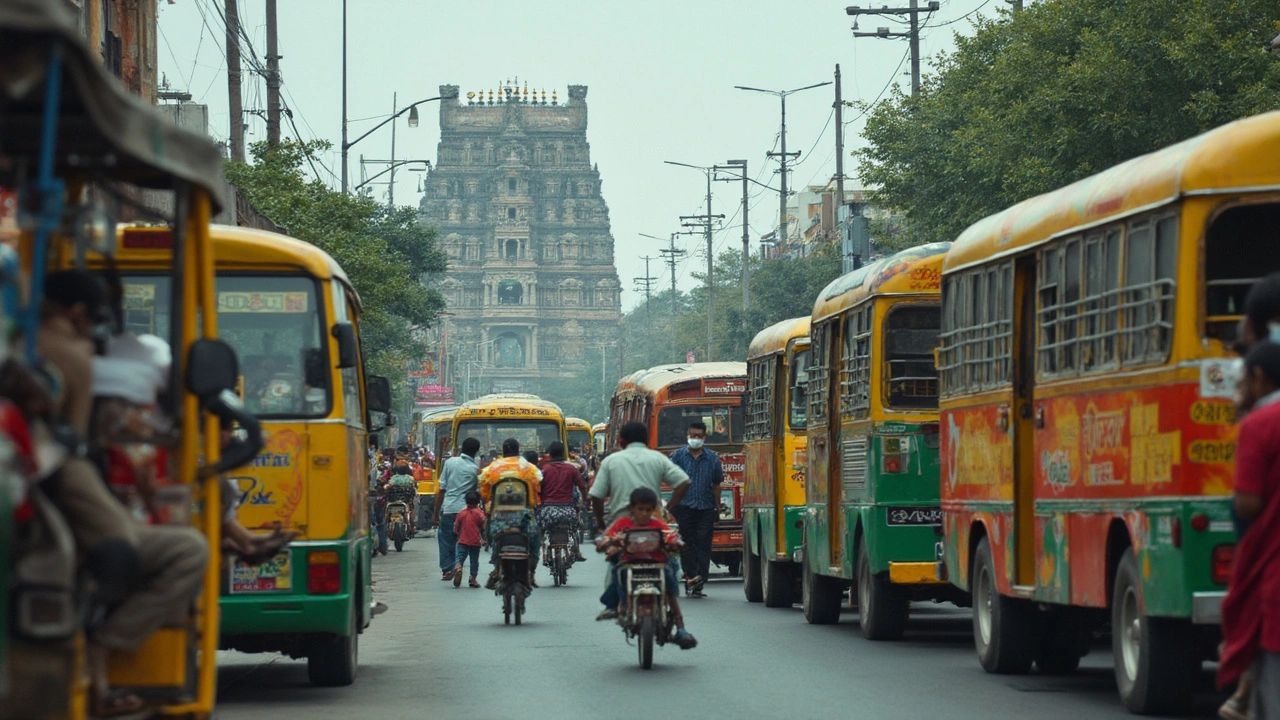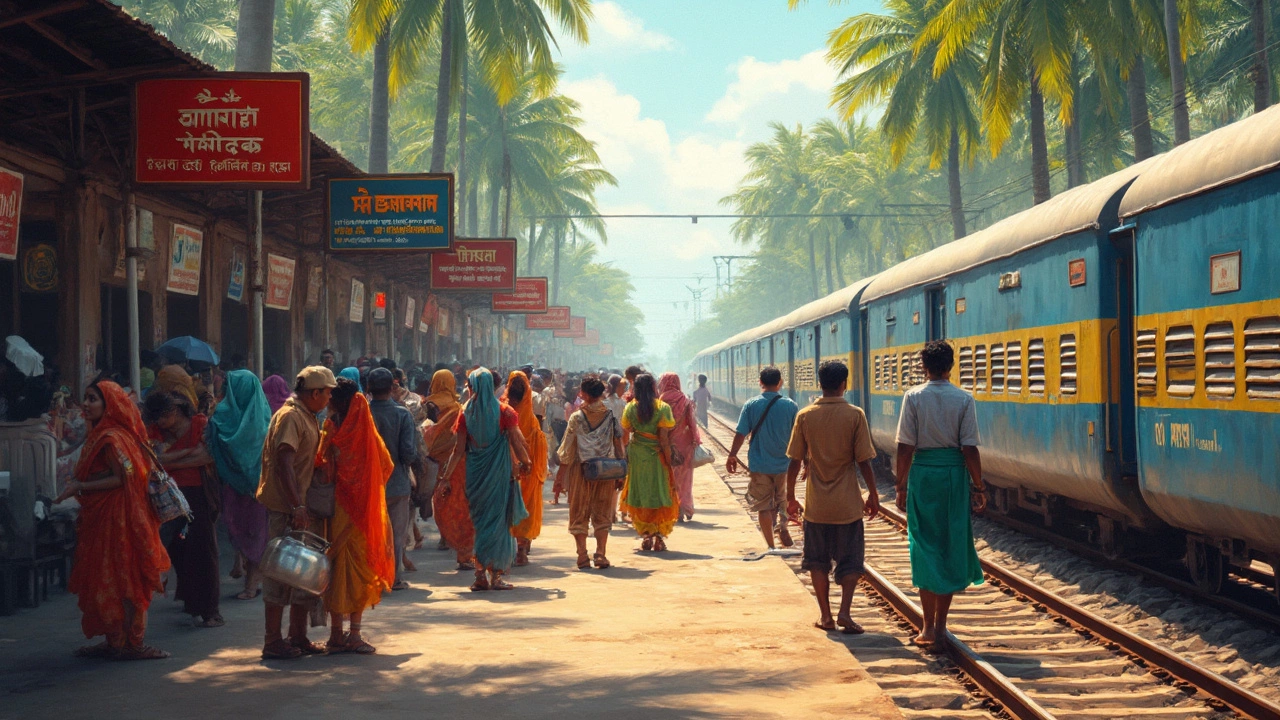Wake up in Mysore, eat dosas for breakfast, then end the day walking barefoot through an ancient temple lit with oil lamps. That’s just a tiny slice of what South India throws at you—the region is bursting with history, food, languages, and, most of all, a mind-blowing diversity of ways to get from A to B. Getting around here isn’t just about getting somewhere; it’s half the adventure. You could be zipping past coconut groves on the back of a rickety motorbike, then find yourself on a sleeper train hurtling through the Western Ghats, or napping next to a goat on a rural bus. Still, navigating South India can be a puzzle if you’re used to the Tube in Bristol. The real magic begins once you figure out how it all works—and which route will turn a long day into a reel-worthy story.
Mastering the Train Lines: The Pulse of South Indian Travel
If South India had a heartbeat, it's the sound of a train clattering over a bridge after a rainstorm. The Indian Railways network here is older than Indian independence, with lines first built by the British in the 19th century. Even now, a staggering 23 million people across the country board a train every single day, and many of those journeys are on routes that snake through South India's lush countryside and buzzing cities.
Here's something most guidebooks gloss over: Not all trains—and not all seats—are created equal. On a hot afternoon in Chennai, the air-conditioned Shatabdi Express whisks you to Bangalore in 5 hours flat, with chai and hot snacks, while other trains cover the same distance but take all night, stopping at towns where the platform isn’t much more than a dusty track and a chai stall. Watch for famous routes: the Nilgiri Mountain Railway, a UNESCO heritage line, hauls you slowly up to the cool hills of Ooty in blue wooden carriages, while the Konkan route, hugging the Arabian Sea, is popular with backpackers heading to Goa and Kerala.
Booking tickets takes planning. Indian trains reserve seats weeks in advance—especially for the best carriages, like 2AC (two-tier air-con) or the elusive First AC. Always book on the official IRCTC website or app; third-party agents can charge silly money for the same trip. Don't have a set itinerary? Each station has quotas for foreigners, kept aside for walk-in travelers. Show your passport, sign the register (and expect to wait in line), and you stand a good chance of snagging a spot even on popular routes.
Trains in South India have character—one moment you’re threading through rubber plantations, another you’re skirting rocky Love Scenery in Kerala. And in sleeper class, you'll share your ride with families unpacking home-cooked lunches, pilgrims on temple circuits, and school kids practicing English. Always carry earplugs, wet wipes, and extra loo roll. And don’t forget the window seat—something about seeing palm trees flying by faster than your thoughts makes train travel here pure magic.
| Famous Train Journeys | Route | Duration |
|---|---|---|
| Nilgiri Mountain Railway | Mettupalayam to Ooty | 5 hours |
| Konkan Express | Mumbai to Mangalore (via Goa) | 14-15 hours |
| Shatabdi Express | Chennai to Bangalore | 5-6 hours |
| Venad Express | Shoranur to Trivandrum | 7-8 hours |
The Art of Surviving (and Thriving) on Indian Buses
If you want to cover ground that trains don’t reach—or you fancy plunging into the chaos head-on—buses become your best mate. South India’s bus network is huge, spanning cities, hill stations, tiny coastal hamlets, and every market town in between. Every state has its own government-run service: KSRTC in Kerala, TNSTC in Tamil Nadu, APSRTC in Andhra Pradesh, and so on. Most cities also have fancy private buses offering a notch more comfort: think reclining seats, power outlets, and in some cases onboard movies. State buses, on the other hand, are cheap, sometimes filled to the roof, and run so frequently that you never have to check a timetable. Just stand by the road, wave your hand, and hop on.
Let’s set up some expectations. Not every bus will have air-con—locals sometimes prefer the open window, fresh wind, and street snacks at every stop. Journeys take longer than Google Maps tells you, thanks to twisty roads, cows in the street, and surprise festivals blocking the route (happens more than you think). Rural buses can stop anywhere—if a vendor needs to load sacks of jackfruit or a wedding procession blocks the road, you'll just soak it up. Move with the rhythm, and you'll see moments you’d never spot in a taxi, like a chicken riding shotgun or farmers selling sweet tea through the bus window at dawn.
When buying tickets, go straight to the station if you’re starting your journey in a big city like Hyderabad or Kochi. Smaller towns don’t always have staffed counters, but the conductor collects fares after you’ve boarded—just tell him your destination and keep the change handy. For overnight trips, especially between major cities, private "sleeper" buses are comfy and bookable online on sites like Redbus or MakeMyTrip. Some routes, such as Mumbai to Bangalore, have luxury Volvo or Mercedes buses with full air-con and blankets. But local short-hop journeys often mean bouncing along in a rickety Ashok Leyland with fans rattling overhead, so pack patience and a sense of humour.
Bus life is where you’ll hear stories, get invitations to visit temples, and try snacks passed down the aisle—paruppu vada (crispy lentil fritters), samosas, or banana chips. Women’s seats are always at the front, and older folks will gently prod you in the right direction if you look lost. Don’t expect much English outside large cities, but a smile, a point at a map, and learning “evide?” (“where?” in Malayalam) or “yenge?” (Tamil) will get you far.

Taking the Road: Hiring Cars, Mopeds, and Taxis Like a Local
Not everything in South India runs on train tracks or bus timetables. Sometimes you want to ditch the crowd and pick your own route. This is where hiring a car, scooter, or trusty auto-rickshaw takes over. Road tripping in South India is addictive—imagine winding coastal drives along Kerala, lush Western Ghats dotted with waterfalls, or temple-hopping from Madurai to Thanjavur, all on your own clock.
Self-drive cars are easy to arrange in big cities. Major global brands like Zoomcar and India’s own Myles Car Rentals let you book by the day, and requirements are simple: bring your passport and a valid driving licence—UK permits are accepted, but always check the small print for IDP (International Driving Permit) rules. Indians drive on the left, like in the UK, but that’s where similarities end. Road etiquette is… flexible. Honking is a language. Lanes are more of a suggestion, and vehicles oncoming might include cows, chickens, tractors, and the superbly patient coconut vendor on his rusty bicycle. Always honk before overtaking, and keep your drive slow on the hairpins around the Nilgiri or Western Ghats. Petrol stations rarely accept card—bring plenty of cash.
Scooters and mopeds are a hit with backpackers, especially in Goa, Pondicherry, and Kerala’s small beach towns. Rentals usually cost less than a cup of latte back in Bristol per day (about 300-500 rupees as of 2025). But always wear a helmet—even if no one else is—and check the brakes before you scoot off. Police do random license checks, especially on foreigners, and riding without a permit can mean a steep on-the-spot fine (and a very long conversation at the local station).
Taxis and auto-rickshaws fill the gap for short hops. Getting a fair price is the trick—apps like Ola and Uber work in big cities, but in smaller places, negotiate before boarding. Don’t be shy about asking around—locals know what’s fair, and drivers respect polite firmness. If you’re moving bags or catching a night train, pre-booking an auto keeps things easy. Pro tip: If you’re on a tight schedule or fancy a taxi for multiple days, you can often hire a driver (and car) for a flat daily rate. This is popular with families or small groups heading for the Western Ghats or out to the Nilgiris, and it often works out cheaper than a string of short rides.
The Other Side: Domestic Flights, Boats, and Walking Trails
Okay, here’s the wildcard. South India is massive—if you’re going from Hyderabad to Trivandrum, or want to hop from the beaches of Karnataka to the temples of Madurai fast, flying is sometimes worth the splurge. Domestic flights are frequent, and routes connect all major cities. Airlines like IndiGo, Air India, Akasa, and Vistara have morning and evening departures between places like Chennai-Bangalore, Kochi-Hyderabad, and Goa-Trivandrum. If you book a few weeks ahead, expect to pay less than a train’s first class fare. Just remember that luggage rules can be strict, with budget airlines charging extra for bags above 15kg.
But that’s not the whole story. Boats and ferries are a thing here, especially in coastal Kerala. The government-run Kerala State Water Transport (KSWTD) ferries are slow, cheap and scenic—think “Venice but sweaty.” You’ll float past fishermen mending nets, stop off at tiny river islands like Poothotta, and share the deck with grannies balancing baskets. Private houseboats, called kettuvallams, cruise Kerala’s backwaters in style, and overnight trips include massive meals cooked fresh onboard—this is easily one of the most peaceful, cinematic ways to see the countryside.
If you’re up for some legwork, head out on the foot trails in Kerala’s Western Ghats or in Karnataka’s coffee-growing hills. Treks like the Kumara Parvatha trail or the Nilgiri walks take you through cloud forests, spice plantations, tea gardens, and wild elephant territory. Guided walks can be booked in places like Munnar or Coorg, but many trails are marked with local signs or waypoints in English and Tamil. Don’t hike alone in remote areas—leopards and elephants have the real right of way here! And always carry water, repellant, and sturdy shoes. If you prefer city exploring, walking lanes in Fort Kochi, Pondicherry’s French Quarter, or the backstreets of Mysore make for the kind of days you’ll talk about for years.
Wherever you go, there’s no single "best" way to get around South India. That's half the fun. Whether you're zipping through morning mist in a crowded bus, winding mountain roads on a scooter, or watching the world drift by from a train bunk, every journey comes stacked with sights, sounds, and stories you couldn't get anywhere else. Challenge yourself to try them all. The more you move, the more alive this part of India feels—and the richer your memories will be when you look back.
